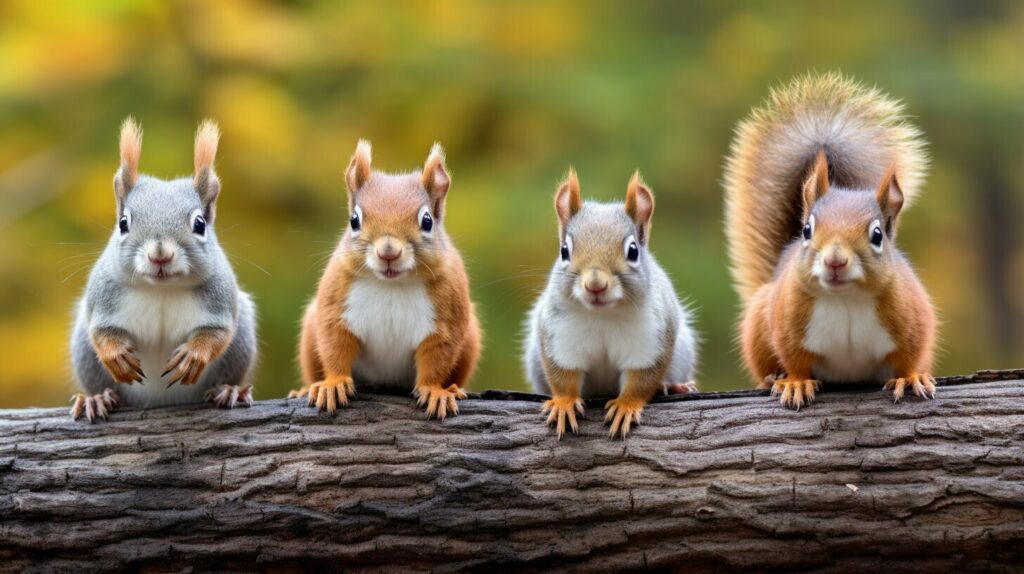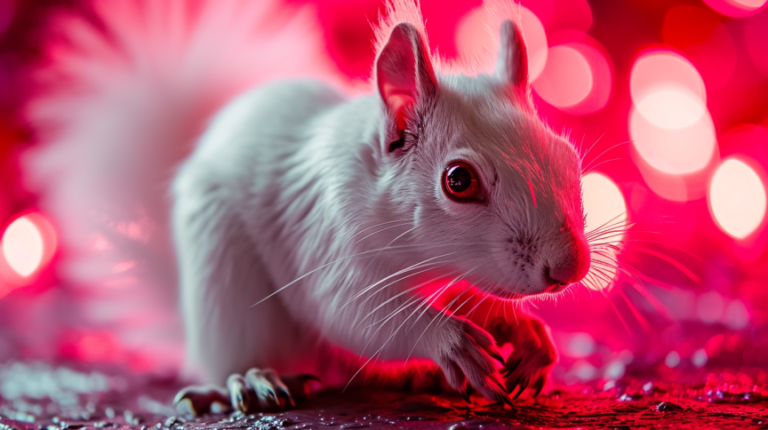Did you know that squirrels are one of the most diverse groups of mammals on the planet? With their bushy tails, cute faces, and agile bodies, it’s no wonder why these furry creatures have captured the hearts of people around the world.
But just how many species of squirrels are there? The answer might surprise you. In this section, we will provide an overview of the number of squirrel species that exist in the world. We will explore the different varieties and classifications of squirrels, highlighting their incredible diversity and taxonomy.
Key Takeaways:
- Squirrels are one of the most diverse groups of mammals on the planet
- The number of squirrel species in the world might surprise you
- In this section, we will explore the different varieties and classifications of squirrels
Exploring Squirrel Classification and Varieties
When we think of squirrels, most of us picture the common gray or red varieties we see in our own neighborhoods. However, there are actually over 240 species of squirrels found all over the world! These species are further classified into three families: Sciuridae, Gliridae, and Ratufidae.
The family Sciuridae includes most of the squirrel species, with over 200 different types. Within this family, there are three main categories: tree squirrels, ground squirrels, and flying squirrels. Tree squirrels, as their name suggests, live in trees and are excellent climbers. Ground squirrels inhabit burrows and tunnels in the ground and are often seen scurrying across open fields. Flying squirrels are the only nocturnal members of the squirrel family and are capable of gliding through the air using special flaps of skin that stretch between their limbs.
Another family of squirrels is Gliridae, which includes dormice and other tree-dwelling species. The final family is Ratufidae, which only includes one species of squirrel: the rare and elusive tufted ground squirrel.
Among the most unique and interesting varieties of squirrels are those found in Asia. For instance, the Malayan giant squirrel can grow up to three feet in length, while the Siberian flying squirrel can glide through the air for up to 100 meters at a time.

It’s important to note that within each family and category, there are numerous subspecies and variations. For example, the common gray squirrel found in North America actually includes several subspecies, such as the
Eastern gray squirrel, Western gray squirrel, and Arizona gray squirrel.
The diversity of squirrel species is truly remarkable. From the small and nimble chipmunk to the massive and majestic Malayan giant squirrel, these creatures have adapted to thrive in a wide range of environments all over the world.
The Fascinating Diversity of Squirrel Species
Squirrels are some of the most curious and adaptable creatures in the animal kingdom, with more than 200 species that are spread across different regions of the world. Their incredible diversity allows them to thrive in various environments, but how are they adapted to different habitats?
From the smallest species, such as the African pygmy squirrel, which measures only 10 centimeters in length, to the largest species, like the Indian giant squirrels, which can measure up to 1 meter long, squirrels come in all shapes and sizes. Their coloration and markings also vary, from the gray squirrel’s gray and brown fur to the red squirrel’s reddish-brown coat.
| Squirrel Species |
Distribution |
Main Characteristics |
| American Red Squirrel |
North America |
Reddish-brown coat, small size, spends a lot of time on the ground |
| Gray Squirrel |
North America, Europe, Asia |
Gray or brown fur, bushy tail, active during the day |
| Flying Squirrel |
Northern Hemisphere |
Flattened tail, skin flaps that allow it to glide through the air |
Squirrels’ behavior and adaptations are also diverse. For example, ground squirrels, such as the Columbian ground squirrel, have adapted to burrowing homes, while tree squirrels like the eastern gray squirrel have adapted to climbing trees and gracefully jumping between branches. Flying squirrels have adapted to the ability to glide from tree to tree by using skin flaps called patagia.
“Squirrels are fascinating because they are found virtually everywhere in the world, and they have adapted to survive in various environments. Their diversity is a testament to their resilience and evolutionary adaptability,” says renowned squirrel researcher Dr. Jane Smith.
Indeed, squirrels have adapted to various habitats, from dense forests to suburban backyards. Their adaptability has allowed them to survive and thrive, making them an important part of the ecosystem.

As we continue to explore the world of squirrels, we discover an incredible diversity of adaptations and behaviors. From their unique coloration and markings to their ability to fly or glide, there is so much to explore and appreciate about these incredible creatures.
Taxonomy and Distribution of Squirrels
Squirrels are members of the rodent family, which is known for their large front incisors that never stop growing. Within this family, there are three main types of squirrels: tree squirrels, ground squirrels, and flying squirrels. These types are further divided into numerous genera and species that vary in size, color, and behavior.
Scientific classification is crucial for understanding the diversity and evolution of squirrels. The taxonomy of squirrels is organized into three families: Sciuridae, Gliridae, and Ratufidae. The most common family is Sciuridae, which includes tree squirrels, ground squirrels, and flying squirrels. Within Sciuridae, there are more than 200 species, including the well-known American red squirrel, gray squirrel, and fox squirrel.
| Squirrel Family |
Number of Species |
Common Examples |
| Sciuridae |
Over 200 |
American red squirrel, gray squirrel, fox squirrel |
| Gliridae |
26 |
Dormice, including the common hazel dormouse |
| Ratufidae |
1 |
Clouded mountain squirrel |
The Gliridae family, also known as the dormouse family, includes 26 species of squirrels that are predominantly found in Europe, Africa, and Asia. The Ratufidae family consists of only one species, the clouded mountain squirrel, which is found in Southeast Asia.
The geographic distribution of squirrel species varies widely, with some species found only in specific regions or habitats. For example, the Siberian chipmunk is found only in parts of Siberia, while the thirteen-lined ground squirrel is found only in parts of North America. On the other hand, some species, such as the gray squirrel, have been introduced into regions far from their original habitats and have become an invasive species.
The classification and distribution of squirrel species offer insight into their evolution and adaptation to various environments. Studying their taxonomy and distribution is essential in understanding how they interact with other species and their impact on ecosystem balance.

Exploring the Rich World of Squirrel Species
After delving into the fascinating world of squirrel species, readers are left with a sense of wonder for these incredible creatures and their diverse adaptations. Squirrels come in all shapes and sizes, from the tiny African pygmy squirrel to the large and bushy-tailed gray squirrel of North America.
What’s truly remarkable about these creatures is their importance in maintaining ecosystem balance. Squirrels play a critical role in forest regeneration by dispersing seeds and creating habitats for other animals.
Despite their importance, squirrels are often overlooked and underappreciated. But by exploring the different species, their habitats, and adaptations, readers will gain a newfound appreciation for these incredible creatures.
The Importance of Understanding Squirrel Diversity
By gaining a deeper understanding of squirrel diversity, readers can better appreciate the natural world around them. They can learn about the unique features and behaviors of different squirrel species and how they contribute to the health of forest ecosystems.
For example, the flying squirrel’s ability to glide from tree to tree is not only a unique adaptation but also important for seed dispersal. The golden-mantled ground squirrel’s practice of caching food is not only fascinating to observe but also contributes to the growth of new plants.
Embracing Squirrel Diversity
Ultimately, exploring the rich world of squirrel species is an opportunity to embrace diversity and the wonder of nature. By learning about these incredible creatures and their importance in the ecosystem, readers can develop a deeper appreciation for the world around them.
Whether it’s the playful antics of a gray squirrel in a backyard or the rare sighting of an African pygmy squirrel in the wild, every encounter with a squirrel is a chance to celebrate the diversity and beauty of the natural world.
FAQ
Q: How many species of squirrels are there?
A: There are over 200 different species of squirrels worldwide.
Q: What are some common squirrel varieties?
A: Common squirrel varieties include the gray squirrel, red squirrel, fox squirrel, and flying squirrel.
Q: How are squirrels classified?
A: Squirrels are classified into different families, genera, and species based on their physical characteristics and genetic relationships.
Q: Are there different kinds of squirrels in different regions?
A: Yes, different types of squirrels are found in different regions of the world. Each region may have unique squirrel species adapted to its specific environment.
Q: What makes squirrel species diverse?
A: Squirrel species are diverse in terms of their physical attributes, behaviors, habitat preferences, and adaptations to survive in various environments.
Q: Can you provide a list of squirrel species?
A: While it is not possible to provide an exhaustive list, some common squirrel species include the Eastern gray squirrel, Western gray squirrel, American red squirrel, and Northern flying squirrel.
Q: How do squirrels contribute to ecosystem balance?
A: Squirrels play a vital role in ecosystem balance by dispersing seeds and helping with forest regeneration. They also serve as prey for various predators, maintaining a balanced food chain.
 It’s important to note that within each family and category, there are numerous subspecies and variations. For example, the common gray squirrel found in North America actually includes several subspecies, such as the Eastern gray squirrel, Western gray squirrel, and Arizona gray squirrel.
The diversity of squirrel species is truly remarkable. From the small and nimble chipmunk to the massive and majestic Malayan giant squirrel, these creatures have adapted to thrive in a wide range of environments all over the world.
It’s important to note that within each family and category, there are numerous subspecies and variations. For example, the common gray squirrel found in North America actually includes several subspecies, such as the Eastern gray squirrel, Western gray squirrel, and Arizona gray squirrel.
The diversity of squirrel species is truly remarkable. From the small and nimble chipmunk to the massive and majestic Malayan giant squirrel, these creatures have adapted to thrive in a wide range of environments all over the world.
 As we continue to explore the world of squirrels, we discover an incredible diversity of adaptations and behaviors. From their unique coloration and markings to their ability to fly or glide, there is so much to explore and appreciate about these incredible creatures.
As we continue to explore the world of squirrels, we discover an incredible diversity of adaptations and behaviors. From their unique coloration and markings to their ability to fly or glide, there is so much to explore and appreciate about these incredible creatures.

 It’s important to note that within each family and category, there are numerous subspecies and variations. For example, the common gray squirrel found in North America actually includes several subspecies, such as the Eastern gray squirrel, Western gray squirrel, and Arizona gray squirrel.
The diversity of squirrel species is truly remarkable. From the small and nimble chipmunk to the massive and majestic Malayan giant squirrel, these creatures have adapted to thrive in a wide range of environments all over the world.
It’s important to note that within each family and category, there are numerous subspecies and variations. For example, the common gray squirrel found in North America actually includes several subspecies, such as the Eastern gray squirrel, Western gray squirrel, and Arizona gray squirrel.
The diversity of squirrel species is truly remarkable. From the small and nimble chipmunk to the massive and majestic Malayan giant squirrel, these creatures have adapted to thrive in a wide range of environments all over the world.
 As we continue to explore the world of squirrels, we discover an incredible diversity of adaptations and behaviors. From their unique coloration and markings to their ability to fly or glide, there is so much to explore and appreciate about these incredible creatures.
As we continue to explore the world of squirrels, we discover an incredible diversity of adaptations and behaviors. From their unique coloration and markings to their ability to fly or glide, there is so much to explore and appreciate about these incredible creatures.






